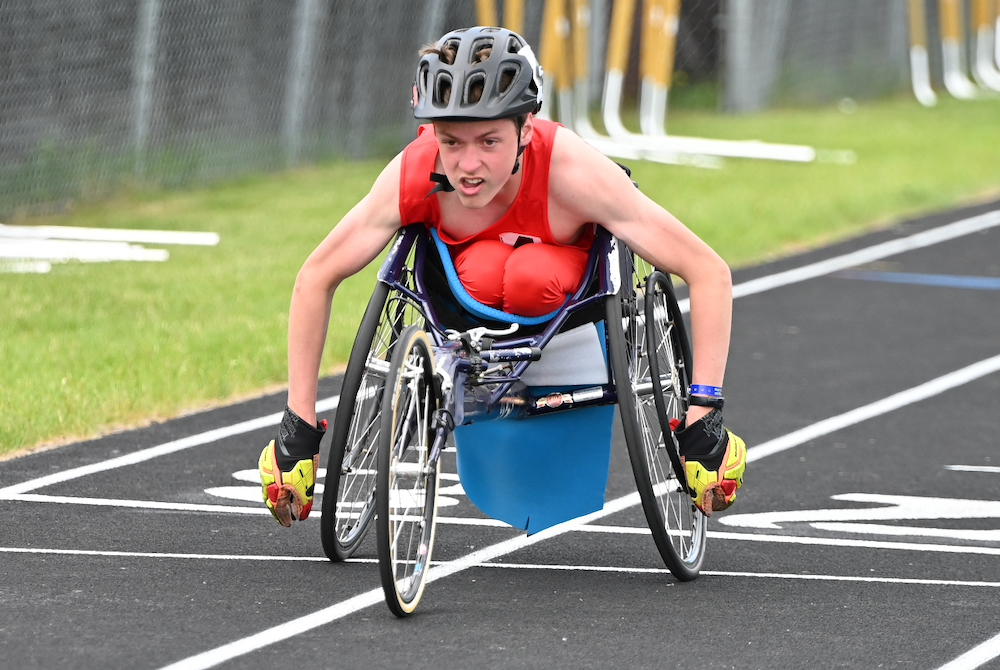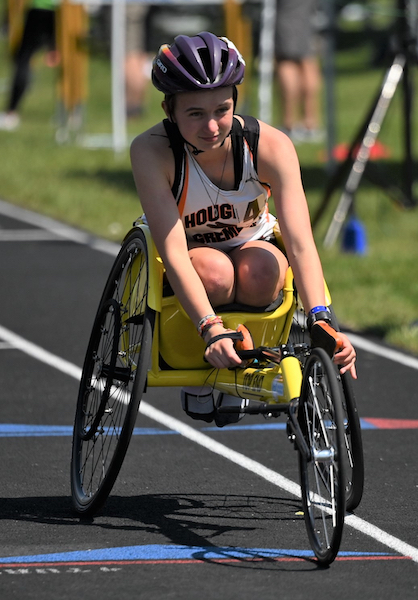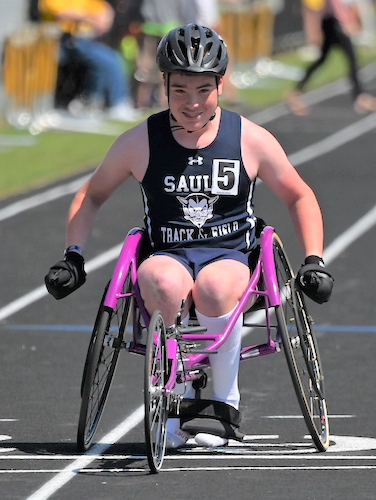
3 Upper Peninsula Athletes Among History-Makers in 1st Finals Adaptive Events
By
John Vrancic
Special for MHSAA.com
June 17, 2022
KINGSFORD — A trio of Upper Peninsula wheelchair athletes were among five statewide who concluded their seasons June 4 competing in first-time adaptive events at MHSAA Finals.
 This spring, the MHSAA Track & Field Regionals and Finals included its first adaptive 100, 200 and 400-meter dashes and shot put.
This spring, the MHSAA Track & Field Regionals and Finals included its first adaptive 100, 200 and 400-meter dashes and shot put.
“Learning the technique and staying motivated is very challenging,” Houghton senior Maria Valet said after the Western Peninsula Athletic Conference meet May 31 at Calumet. “I go to regional competition downstate and in Indiana and Wisconsin. I also do little bit of weight training, but practice mostly on the track. I also work a little bit with Dean Juntunen (a longtime wheelchair racer from Ontonagon), who gives me some pointers. It’s good to have something to work for and see other people do it.”
 Joining Velat at the Upper Peninsula Finals in Kingsford were Marquette freshman Jim Bennett and Sault Ste. Marie freshman Johnny Osborn.
Joining Velat at the Upper Peninsula Finals in Kingsford were Marquette freshman Jim Bennett and Sault Ste. Marie freshman Johnny Osborn.
Velat covered the 100 in 26.56 seconds, 200 (51.15) and 400 (1:35.96) and recorded a 10-foot toss in shot put.
Her effort in the 400 at the Finals was nearly a personal-best.
“My best time in the 100 is 25.7 and I’ve done the 200 in approximately 48 seconds,” she said. “I think the 100 is my hardest event because it’s harder to gain momentum.”
Velat will attend the University of Michigan and major in biology. She will also be on the track team.
Bennett shattered his previous best time in the 200 by more than 2½ seconds was clocked at 24.31 in the 100 and 1:39.74 in the 400.
“It feels real good to race against other people,” he said. “I haven’t had the opportunity to do this before. There are so many opportunities available. Colleges are looking for wheelchair racers.
 “Today was my best time in the 200 (47.52). It feels great to do that. I had my best time in the 100 (23.15) in Marquette. The longer distances are more challenging for me. Right now I’m building up.”
“Today was my best time in the 200 (47.52). It feels great to do that. I had my best time in the 100 (23.15) in Marquette. The longer distances are more challenging for me. Right now I’m building up.”
Osborn threw the shot 13-4 at Kingsford, missing his personal best by just two inches.
“It means a lot to me to get a chance to compete,” he said. “This helps bring out the competitive spirit. I do cross country, which gives me more endurance and definitely helps me for track. I also manage the basketball team at our school.”
Osborn finished the 100 in 33.18, 200 in 1:17.95 and 400 in 2:21.03.
In the Lower Peninsula, Chelsea junior Jacob Nelson competed in the Division 2 100 meters, and Grosse Pointe Woods University Liggett junior Jacob Juip competed in the Division 3 100 and 200.
 John Vrancic has covered high school sports in the Upper Peninsula since joining the Escanaba Daily Press staff in 1985. He is known most prominently across the peninsula for his extensive coverage of cross country and track & field that frequently appears in newspapers from the Wisconsin border to Lake Huron. He received the James Trethewey Award for Distinguished Service in 2015 from the Upper Peninsula Sportswriters and Sportscasters Association.
John Vrancic has covered high school sports in the Upper Peninsula since joining the Escanaba Daily Press staff in 1985. He is known most prominently across the peninsula for his extensive coverage of cross country and track & field that frequently appears in newspapers from the Wisconsin border to Lake Huron. He received the James Trethewey Award for Distinguished Service in 2015 from the Upper Peninsula Sportswriters and Sportscasters Association.
PHOTOS (Top) Marquette's Jim Bennett races during the UP Finals on June 4. (Middle) Houghton's Maria Velat competed in all four adaptive Finals events in UPD1. (Below) Sault Ste. Marie's Johnny Osborn also competed in all four events at Kingsford. (Photos by Cara Kamps/Run Michigan.)

Track Gaining Speed Toward Future with Electronic Starting Devices
By
Steve Vedder
Special for MHSAA.com
May 23, 2023
Aubrey Greenfield thinks it might be the perfect time to reevaluate 130 years of tradition.
For a number of reasons, from technical to personal, the Oxford senior sprinter believes it makes sense for the crack of a starting pistol to be eliminated from high school track meets.
Because track meets would benefit in various ways from lowering costs to easier setup at meets to the human factor of competitors not having to flinch at the crack of a pistol shot, Greenfield believes the sport has a chance to embrace new technology – electronic starting devices (ESD).
In essence, an ESD replaces the starting pistol with a light flash, tone sound or both to begin a race.
"High school sports should put the athlete first," Greenfield said. "We should promote sports, and eliminating starting pistols promotes health in terms of PTSD or trauma for athletes and spectators and that would be good. I would like to think people would say that's a good idea."
In fact, Greenfield would go as far as to say if there was not an implementation of electronic starting devices, many of her teammates would have considered giving up the sport.
"If it's something that helps us compete safely, we're all for it," she said.
Greenfield's opinion apparently is spreading. Michigan High School Athletic Association senior assistant director Cody Inglis said the use of ESD makes it both affordable for meet starters and sensible for athletes and fans to rethink the use of starting pistols. While the MHSAA is not mandating electronic starting devices, it does promote the use of what Inglis calls "emerging technology." He notes that ESD are becoming the norm for organizations such as USA Track & Field, the NCAA and an increasing number of high schools.
 "I think we have to embrace new technology, and we think this will be something that takes hold," Inglis said.
"I think we have to embrace new technology, and we think this will be something that takes hold," Inglis said.
A key part of embracing ESD is the human element. The tragic Oxford High School shooting Nov. 30, 2021, that took the lives of four students while injuring seven others should not be relived even for a fleeting instance at a high school sporting event. Oxford athletic director Tony DeMare said the school began using ESD at every meet, including the MHSAA Lower Peninsula Division 1 Finals last June. He said that decision was embraced by virtually all schools Oxford encountered.
"We were very convinced that the alternative (of ESD) would promote a healthy attitude," DeMare said. "We were overwhelmed with the positive response. If a school was on the fence about it or might not be for it, I think we've started to see the tide turn in favor of people willing to listen and learn about electronic starting devices."
Inglis said the MHSAA is acutely aware of what the crack of a starting pistol can mean to athletes and fans.
"It's unimaginable what Oxford went through, and this is a small way we can help," he said. "We look at a (starting pistol) and think, ‘Could we do something else?’ It's a way of helping to solve a problem."
Over the last several years, the MHSAA has embraced finding an alternative to starting pistols. Inglis noted the discussion started with the cost and diminishing availability of 32-caliber ammunition that meet starters use. A box of ammunition, if it can be found, is around $75 a box.
In addition to cost, there is potential damage from excessive exposure to 150-plus decibels of sound generated by the traditional 32-caliber blanks. Medical studies show damage to ears caused by decibel levels above 120 dB.
The tragedy at Oxford accelerated the conversation.
Inglis said the cost of ESD can be likened to a school sinking money into artificial surfaces at football fields. Yes, there is a great cost at first, but over time money is ultimately saved. An ESD system itself ranges between $200 and $500. Speakers also may need to be purchased, but with ESD starting events like the 800 and 1,600-meter relays positioned near the outside lanes 8, 7, 6 and 5 would result in improved hearing by athletes at the start of a race.
There is one challenge with ESD that track administrators are working to overcome – lighting conditions that lessen the ability to see the ESD’s LED light or strobe when the button is pressed by a starter to begin a race. But that vision difficulty resulting from clear blue skies and backgrounds of setting suns can be substantially improved by incorporating a black background with an ESD – something as simple as a starter holding up black cardboard behind the lighting mechanism at the start of an event.
Inglis said when all factors are considered, the use of ESD makes sense.
 "With the climate we live in nowadays, no lookalike guns is good," he said. "We're not mandating this. But people are saying this is affordable."
"With the climate we live in nowadays, no lookalike guns is good," he said. "We're not mandating this. But people are saying this is affordable."
While switching to ESD would break 130 years of tradition, the timing could be a step forward, said Jeff Hollobaugh, co-author of the book "The Fleet Feet of Spring: Michigan's High School State Championships in Track & Field." He said while no definitive answer is possible, it's likely starting pistols were used at the inaugural state meet at the Jackson Fairgounds in 1895. The meet, which included events like tossing a 16-pound shot put, bike races and a 100-meter sprint, was sponsored by the Michigan Interscholastic Athletic Association (a predecessor to the MHSAA) and comprised mostly of the state's larger schools.
Hollobaugh's sentiments echo what many involved in today's high school track & field believe in terms of making a transition from starting pistols to electronic starting devices.
"It's a change, not necessarily good or bad, just different," he said. "It's not a drastic change, but it will take some getting used to. But it is the future. In the end, we'll all be fine."
DeMare believes the future of high school track will definitely include ESD.
"Our desire is that the practicality and sensibility of this will overcome the alternative," he said. "I think we'll see the automation and electronics taking hold of certain elements in track, and people will embrace it."
PHOTOS (Top) Runners watch official Bertha Smiley as they prepare to begin a race during last season's Lower Peninsula Division 1 Finals at Rockford. (Middle) An electronic starting device provided by VS Athletics was used to start those races. (Below) Smiley sets to begin an event. (Photos provided by David Kuderka/VS Athletics.)

